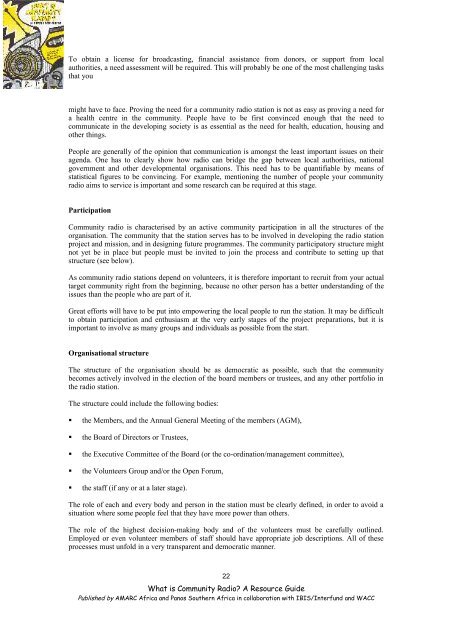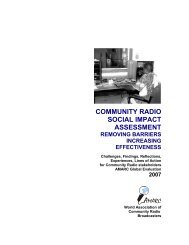WHAT IS COMMUNITY RADIO - amarc
WHAT IS COMMUNITY RADIO - amarc
WHAT IS COMMUNITY RADIO - amarc
Create successful ePaper yourself
Turn your PDF publications into a flip-book with our unique Google optimized e-Paper software.
To obtain a license for broadcasting, financial assistance from donors, or support from local<br />
authorities, a need assessment will be required. This will probably be one of the most challenging tasks<br />
that you<br />
might have to face. Proving the need for a community radio station is not as easy as proving a need for<br />
a health centre in the community. People have to be first convinced enough that the need to<br />
communicate in the developing society is as essential as the need for health, education, housing and<br />
other things.<br />
People are generally of the opinion that communication is amongst the least important issues on their<br />
agenda. One has to clearly show how radio can bridge the gap between local authorities, national<br />
government and other developmental organisations. This need has to be quantifiable by means of<br />
statistical figures to be convincing. For example, mentioning the number of people your community<br />
radio aims to service is important and some research can be required at this stage.<br />
Participation<br />
Community radio is characterised by an active community participation in all the structures of the<br />
organisation. The community that the station serves has to be involved in developing the radio station<br />
project and mission, and in designing future programmes. The community participatory structure might<br />
not yet be in place but people must be invited to join the process and contribute to setting up that<br />
structure (see below).<br />
As community radio stations depend on volunteers, it is therefore important to recruit from your actual<br />
target community right from the beginning, because no other person has a better understanding of the<br />
issues than the people who are part of it.<br />
Great efforts will have to be put into empowering the local people to run the station. It may be difficult<br />
to obtain participation and enthusiasm at the very early stages of the project preparations, but it is<br />
important to involve as many groups and individuals as possible from the start.<br />
Organisational structure<br />
The structure of the organisation should be as democratic as possible, such that the community<br />
becomes actively involved in the election of the board members or trustees, and any other portfolio in<br />
the radio station.<br />
The structure could include the following bodies:<br />
� the Members, and the Annual General Meeting of the members (AGM),<br />
� the Board of Directors or Trustees,<br />
� the Executive Committee of the Board (or the co-ordination/management committee),<br />
� the Volunteers Group and/or the Open Forum,<br />
� the staff (if any or at a later stage).<br />
The role of each and every body and person in the station must be clearly defined, in order to avoid a<br />
situation where some people feel that they have more power than others.<br />
The role of the highest decision-making body and of the volunteers must be carefully outlined.<br />
Employed or even volunteer members of staff should have appropriate job descriptions. All of these<br />
processes must unfold in a very transparent and democratic manner.<br />
22<br />
What is Community Radio? A Resource Guide<br />
Published by AMARC Africa and Panos Southern Africa in collaboration with IB<strong>IS</strong>/Interfund and WACC

















